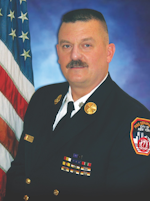Different fire departments and companies use different terminology for similar tasks, and stretching a hoseline is no exception. The term “start a line” is one such task, and it means to begin to stretch a hoseline. In many fire departments, the engine officer is charged with making the decision. However, obviously, any officer who discovers a condition that requires a hoseline will make that known, and “start a line” will get that operation underway.
Beyond the ‘stretch’
What exactly are you calling for when you order a hoseline stretched? What size or diameter hose do you want firefighters to pull? How many lengths of hose are required? Will the firefighters stretch a preconnected line where they know the number of lengths that are attached, or must they stretch the number of lengths that are needed off of a larger bed full of hose? Where does the officer want the hoseline stretched? In the front door, to the side door, up the fire escape?
Many questions must be answered before firefighters can properly “start a line.”
Selecting the correct diameter line is vital for an effective hoseline operation. Most engines have 1¾- and 2½-inch handlines. Some still have 1½-inch, and still others have 2-inch attack lines.
Generally speaking, smaller diameter hose is adequate for residential fires, and residential isn’t limited to private dwellings or house fires. A three-story apartment building that has two apartments on each floor is residential, and using a 1¾- or 1½-inch line will work. Some departments don’t use either of those but instead have a 2-inch line as their small or residential attack line. All three hoseline diameters, when properly pumped, provide sufficient water for a typical residential fire load.
The number of lengths of hose that are needed is another important element of a successful hoseline stretch. An engine that’s equipped with preconnected hoselines that have a specific number of lengths might make things a little easier than when a deadload is involved, because the latter can contain more than a dozen lengths. For the preconnect, the officer can order the “long” or the “short” line, and the firefighters will know exactly what is desired. The long line might have five or six lengths of hose; the short line has just four. The officer will decide based on the fire’s location and the route that the line must take to reach it.
If your engine has a hosebed(s) that has a large pile of hose—let’s say, six lengths of 1¾-inch hose connected to and on top of 10 lengths of 2½-inch hose—you must know how many lengths of hose are required and break the line when that number of lengths is pulled off of the rig.
The destination
Where is the hoseline being stretched? Into the building, or to protect an exposure? Into the front door, or down an alley or driveway to a side entrance? Up a fire escape ladder to an upper floor, or into an exposed building? All of these options might be possible, and the officer who orders the line to be stretched must decide and then relay that information to the firefighters who will stretch the attack line.
Another important point: These previously discussed issues can have an effect on each other. For example, the officer might order a 1¾ -inch line to the front door, so it can be stretched up the interior stairway to a second-floor fire. That individual also might order the “small” line, knowing that only four lengths are needed to reach the fire. However, if that same officer orders the line stretched to the side entrance for a fire in the same location, the four-length line might not reach its objective, and a different preconnected line might have to be used.
It’s in the details
Stretching an attack hoseline is more complex than it appears, and well-trained, disciplined engine company firefighters and officers can have a dramatically positive effect on the overall fire attack strategy. Remember these points the next time that you hear, “Start a line!”

John J. Salka Jr. | Battalion Chief
JOHN J. SALKA JR., who is a Firehouse contributing editor, retired as a battalion chief with FDNY, serving as commander of the 18th battalion in the Bronx. Salka has instructed at several FDNY training programs, including the department’s Probationary Firefighters School, Captains Management Program and Battalion Chiefs Command Course. He conducts training programs at national and local conferences and has been recognized for his firefighter survival course, “Get Out Alive.” Salka co-authored the FDNY Engine Company Operations manual and wrote the book "First In, Last Out–Leadership Lessons From the New York Fire Department." He also operates Fire Command Training, which is a New York-based fire service training and consulting firm.






